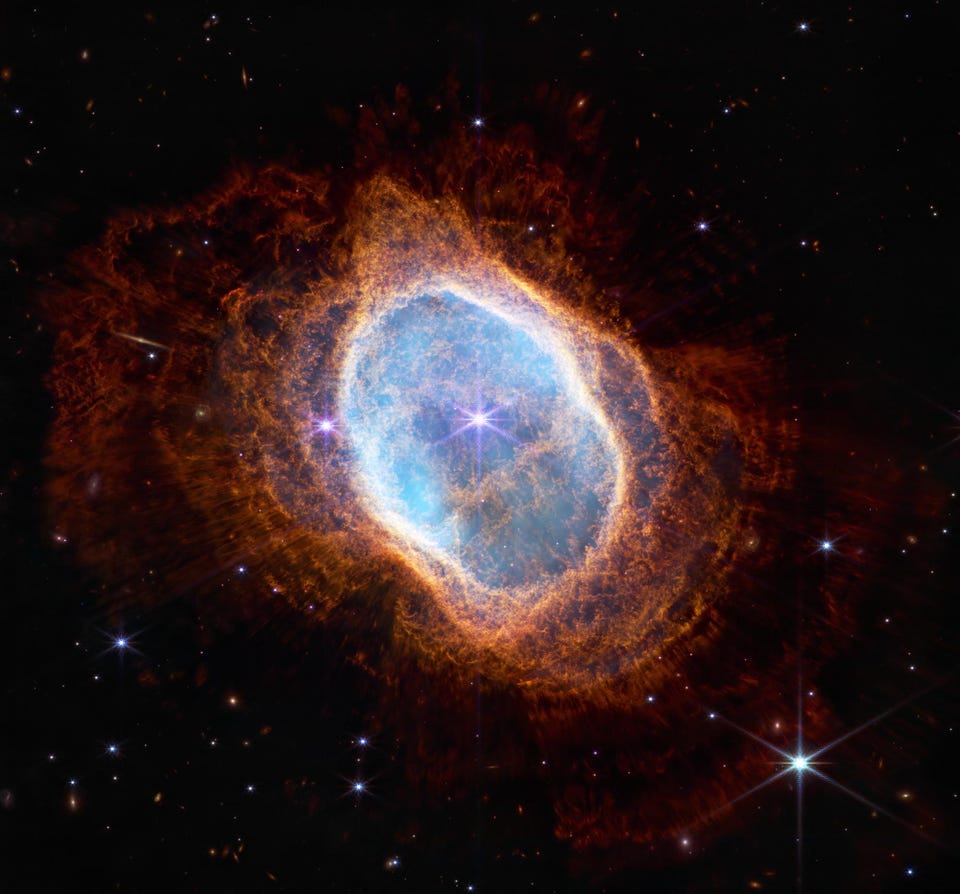Science This Week’s New Space Images From The Webb Telescope And More Will Make Your Jaw Drop Jamie Carter Senior Contributor Opinions expressed by Forbes Contributors are their own. I inspire people to go stargazing, watch the Moon, enjoy the night sky New! Follow this author to improve your content experience. Got it! Jul 16, 2022, 08:00pm EDT | Share to Facebook Share to Twitter Share to Linkedin The Southern Ring Nebula, as captured by the James Webb Space Telescope (JWST).
NASA, ESA, CSA, and STScI It’s been one helluva week for space images. Deepest view of the cosmos ever? Tick. A couple of major rocket launches? Tick.
The year’s last supermoon rising? Tick. That’s only the start, with two new surprising views of Jupiter and a Hubble classic helping create a landmark week in cosmic photography. Here are the standout images from the week just gone and the story behind them: The Carina Nebula, as captured by the James Webb Space Telescope (JWST).
NASA, ESA, CSA, and STScI NASA, ESA, CSA, and STScI Webb’s ‘Cosmic Cliffs’ A close-up of the Carina Nebula—a nursery 7,600 light-years distant—shows apparent ridges, valleys and pillars of hot dust and gas. Like all of Webb’s first targets it’s in the southern hemisphere’s night sky—that just happened to be where Webb was pointed during July 2022. The Southern Ring Nebula, as captured by the James Webb Space Telescope (JWST).
NASA, ESA, CSA, and STScI Webb’s ‘Southern Ring’ Nebula This colorful object is a planetary nebula—an expanding cloud of gas surrounding a dying star. It’s around 2,000 light years distant in the constellation Vela. MORE FOR YOU New Research Finds A Connection Between Domestic Violence And These Two Personality Disorders This Scientist Helps Andean Forests And Ecuador’s Women In STEM Exceptional Fossil Preservation Suggests That Discovering Dinosaur DNA May Not Be Impossible Galaxy cluster SMACS 0723, known as Webb’s First Deep Field.
NASA, ESA, CSA, STScI, Webb ERO Webb’s first ‘deep field’ One of the deepest images of our universe that has ever been taken, this incredible “deep field” shows a massive foreground galaxy cluster called SMACS 0723 magnifying and distorting the light of objects behind it. In an enormous new image, NASA’s James Webb Space Telescope reveals never-before-seen details of . .
. [+] galaxy group “Stephan’s Quintet” NASA, ESA, CSA, and STScI Webb’s galaxy quintet About 290 million light-years aways in the constellation Pegasus, this is a group of five galaxies, four of them comprising the first compact galaxy group ever discovered in 1787. Also known as Hickson Compact Group 92, three have distorted shapes, spiral arms and clumps of stars tell-tale signs that they’ve had close encounters with each other.
Revere, Massachusetts – July 13, 2022: A supermoon, âBuck moonâ, rises over Graves light house in . . .
[+] the Boston Harbor islands as seen from Revere beach in Revere, Massachusetts on July 13, 2022. (Photo by Joseph Prezioso/Anadolu Agency via Getty Images) Anadolu Agency via Getty Images A rising ‘Buck Supermoon’ over Massachusetts The third “supermoon” of 2022 and the first full Moon of summer 2022, the “Buck Moon” rose in dramatic red and orangey hues on Wednesday. The globular cluster Terzan 2 in the constellation Scorpio is featured in this observation from the .
. . [+] NASA/ESA Hubble Space Telescope.
ESA/Hubble & NASA, R. Cohen Hubble’s glittering globular Not to be totally outdone by its newer space telescope rival, the Hubble Space Telescope casually snapped this globular cluster called Terzan 2. In the constellation Scorpio, it’s a tightly gravitationally bound cluster of tens of thousands of stars whose heart is crowded with glittering, colorful stars.
ESA’s new Vega-C rocket lifted off for its inaugural flight VV21 at 15:13 CEST/13:13 UTC/10:13 local . . .
[+] time from Europe’s Spaceport in French Guiana. ESA – M. Pedoussaut Europe launches its new Vega-C rocket The European Space Agency’s brand new Vega-C rocket lifted off for its inaugural flight this week from Europe’s Spaceport in French Guiana.
It will help the ESA move away from using Russian Soyuz rockets, which used to launch from French Guiana until Russia invaded Ukraine. NASA’s Juno spacecraft’s JunoCam captured this close-up on July 7, 2022 on its perijove 43 orbit. .
. . [+] Processed by citizen scientist Kevin M.
Gill. NASA/JPL-Caltech/SwRI/MSSS/Kevin M. Gill NASA’s Juno flew by Jupiter The Juno spacecraft sent back yet another batch of data from its latest close flyby on July 7, which were this week processed by citizen scientists—such as the prolific Kevin M.
Gill, above—into exquisite close-ups of the planet’s swirling storms and cloud tops. Jupiter, center, and its moon Europa, left, are seen through the James Webb Space Telescope’s NIRCam . .
. [+] instrument 2. 12 micron filter.
NASA, ESA, CSA, and B. Holler and J. Stansberry (STScI) Webb’s ‘secret’ image of Jupiter and Europa Days after Webb’s first images NASA decided to publish new images of Jupiter acquired while testing various facets of the telescope’s capabilities.
Included were some spectacular images of the giant planet and its moon Europa taken by NIRCam. Also included were images of Jupiter’s delicate rings. Wishing you clear skies and wide eyes.
Follow me on Twitter or LinkedIn . Check out my website or some of my other work here . Jamie Carter Editorial Standards Print Reprints & Permissions.
From: forbes
URL: https://www.forbes.com/sites/jamiecartereurope/2022/07/16/here-are-this-weeks-jaw-dropping-new-space-images-you-missed-from-webbs-first-images-to-a-supermoon-jupiter-and-more/



